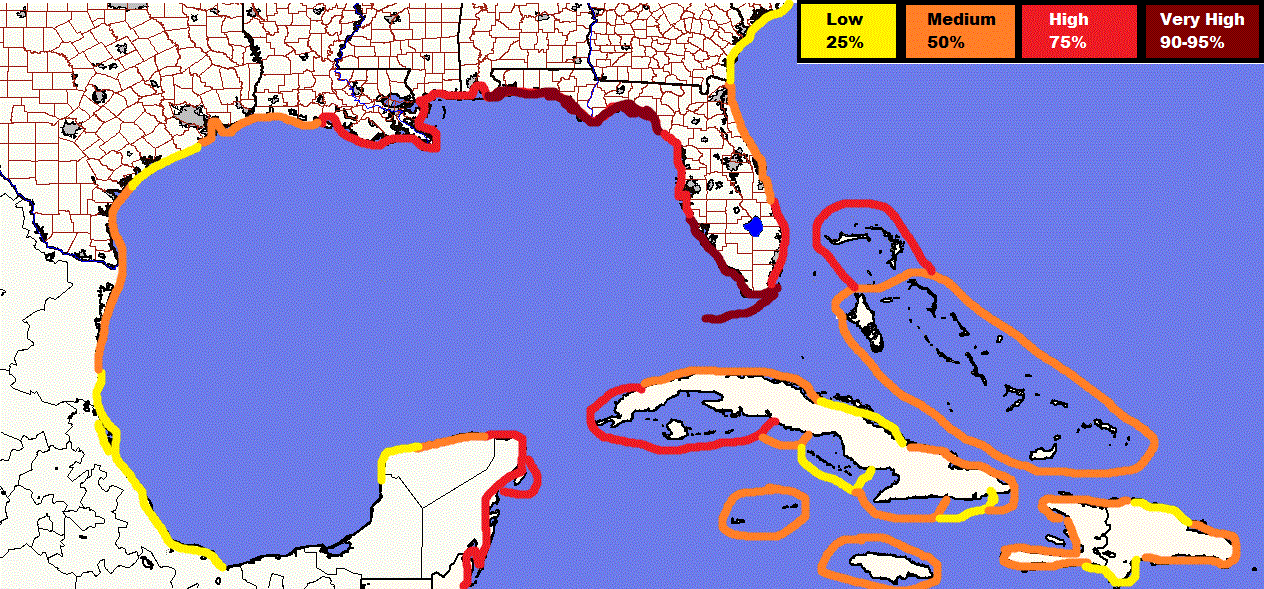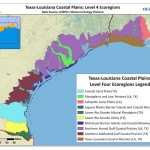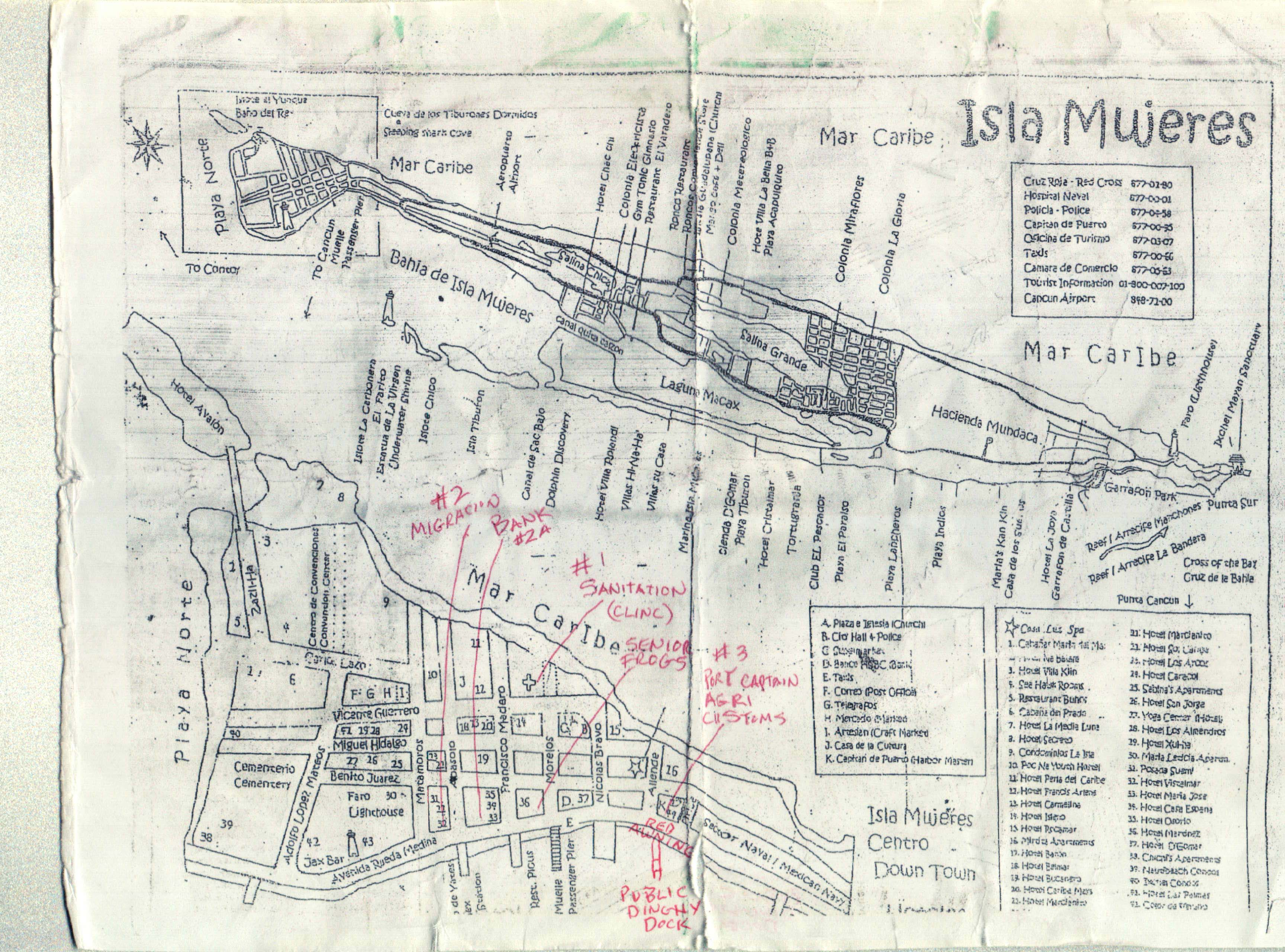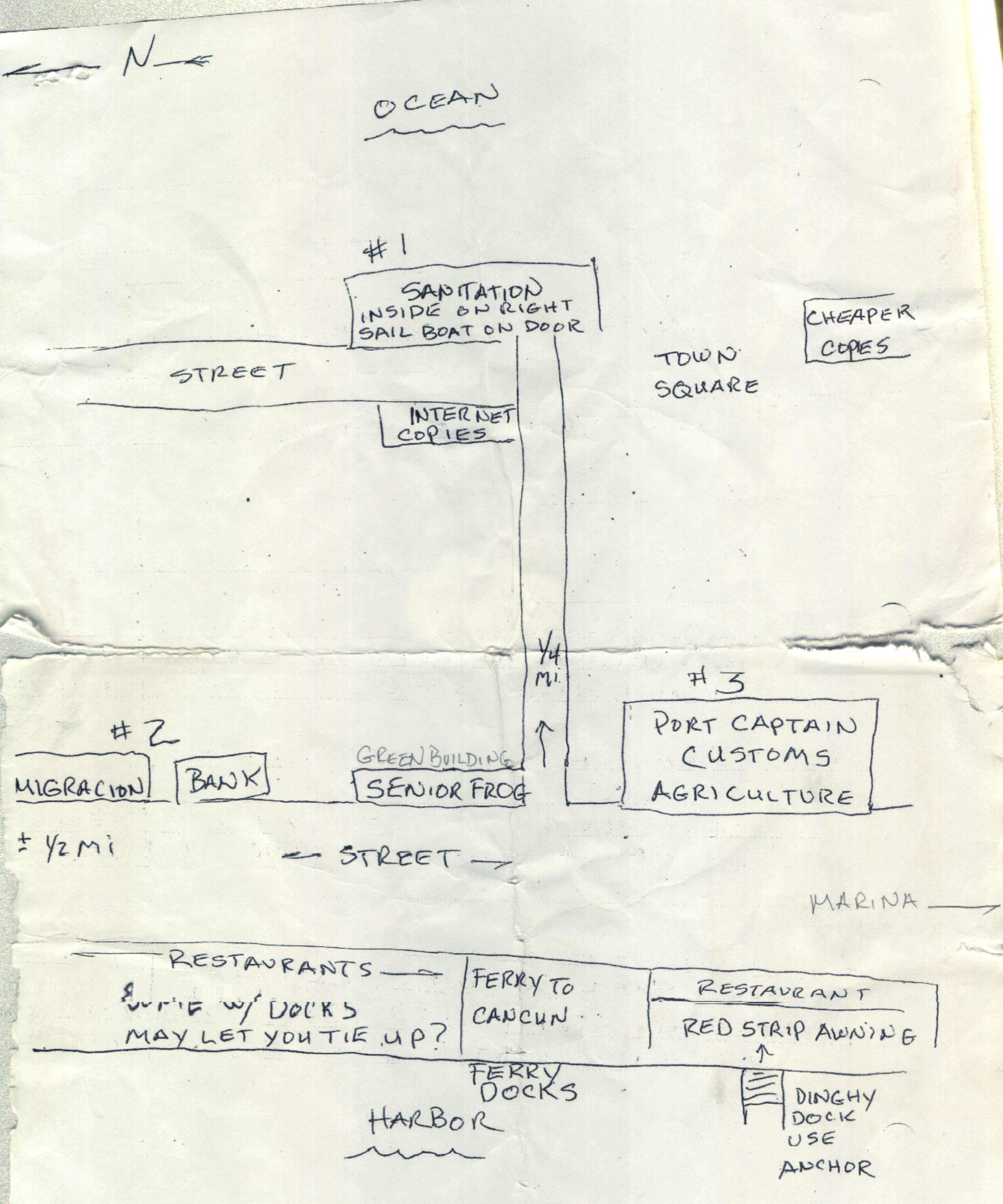Remember last week when we made a big ol’ announcement about the S/V Mother Jones crew coming home to Texas for the summer (aka hurricane season)? ‘Member how that update included lists about stuff we did and did not have “figured out”? And, finally, might you remember how the following info about the boat was neatly bullet-ed in the “figured out” list:
“S/V Mother Jones is staying in Isla Mujeres, in a marina, in the inner lagoon for the 90 days we’re not with her (which also happens to be 90 days of hurricane season, dun, dun, DUN)”
Well, you can just scratch that off the “figured out” list! (shocker: I did that in the old post ’cause I’m OCD like that)
After talking to some super-duper-smart people for the last week or so here in Isla and doing a TON of online research and outreach, we got to thinking seriously about other options. Namely, the option we’re leaning towards now: bringing MJ back to Texas, hauling her out* and putting her on the nicest patch of solid, “high” ground we can find along the TX coast. *Instead of hauling out, we have considered leaving her on a floating dock with 10’+ pilings – out of the way of other boats??? Suffice it to say, our jury (of two) is still out on this one.
If you’re a land-lubbing friend of ours back in ATX, you might read this update and think, “Cool, maybe I’ll get to see the boat”. Feel free to stop reading now 🙂 But, if you’re a sailor – especially one who is trying to find out what to do with your boat for hurricane season – you might be interested to know the nitty-gritty of how we arrived at our decision to change course 180 degrees from leaving our boat here in Isla to setting sail over 700 miles of the Gulf and bringing her home.
Still reading? OK, get ready for some nitty-gritty sailor dork out time. In the spirit of continuing (my) education and paying it forward, I’m gonna use this post as an opportunity to resurrect the algebra student in me and “show my work”.
***Full disclaimer: I’m just diving into all of this stuff, learning as much as I can, as fast as we can (Hurricane Season officially started June 1st, you know, 4 days ago . . .).***
I hope to add to this list as I learn more and I hope you’ll help me correct any of my assumptions if I should know better. Afterall, we don’t know what we don’t know, right? Consider this your open invitation for solicited advice. All that being said, here’s the deal y’all:
- We’ll be working in Austin July-October.
- We are not planning on sailing the boat during this time.
- Bringing the boat back to Texas would allow us to check on her easier (than in Mexico, or the Rio), would allow easier transport of the dog (yay, K is coming home, too!) and allow us to have easy access to any items we have aboard that we want in Austin.
- While we’re not that keen on cruising the Texas coast after years of gin-clear water and almost zero regulations (Why hello there, TPWD, tax office, marinas that require insurance, etc), we aren’t quite sure what we want to do next.
- Another thing we do know is that we will need a bottom job within the next year, requiring a haul-out.
So, considering all that, having MJ close by in Texas, totally stripped and strapped down in an affordable yard seems like the best fit for us. (as of this writing) “Great! But, isn’t Texas in the Hurricane Zone? Where will you leave MJ and what will you do to prep her? Do you have to pay taxes and register MJ in Texas? Isn’t crossing the Gulf, like, a big deal?” Wow. Those are a lot of totally great questions. It’s like you read my mind or something . . . Here goes some answer ‘splaining to those questions: Do you have to pay taxes and register MJ in Texas?
- Yes. (arrg, Ben Franklin!; dead for 200 years, still right)
- Even though she is documented with the US Coast Guard, we will still have to pay to register her in Texas and we have to pay a boat sales & use tax.
- Why do we have to pay? When we bought MJ in Florida, we were never required to pay sales tax on her or register her in any state because we left Florida – and the US – within 90 days. So, now that she is being registered in TX (a US state with sales tax) we have to pay.
- How much, to whom and by when? Well that depends on our bill of sale and how soon we pay it. Apparently, there is a 90 day grace registration to pay the $110 state registration, 20 working days to show taxes paid (rate is 6.25%). If we’re delinquent on any of that stuff we’d accrue penalties & interest of 5% of the tax within 30 days, 10% within 60 days + interest at a rate of 1%. Confusing? Yes. But, luckily, TPWD makes it easy to show how much you potentially owe them through this handy-dandy tax calculator. Ain’t that sweet of them?
- I’m still not sure on where we pay our taxes – county of residence or county of the boat. So, stay tuned on that piece . . .
- It’ll end up being around $3K, which is a lot to us. But, it’s way less than what could potentially happen if we left her unattended without easy access to check on her (Mexico, the Rio, etc) during hurricane season (and beyond?).
- And, what about insurance? That’s a great question, too. We haven’t had it since we left The Bahamas over a year ago. We haven’t met a ton of sailors who have it outside the US. But, it seems lots of US marinas require liability and insurance in a hurricane zone does seems like a good idea, so we’ll see . . . (cue your recs here)
Should we haul out or keep her in the water? Great question! There’s a ton of debate on this. And, from what I can tell the answer is a simple, two-parter: “I dunno.” and “It depends.” Here’s what I can tell:
- In the water: Boats do great in the water on floating docks with pilings taller than the expected surge unless another boat in your area breaks free and starts to play Smash Boat with every boat in it’s path.
- On land (also called dry storage): Boats hauled out on solid, high ground, secured with tie downs on braces also do well. Trouble is, it can be tough to find hard, high ground at sea-level. And, boats on weak stilts, in mushy ground can topple over like dominoes or become aloft (especially cats) if they’re not strapped down properly.
BTW – I’ve attempted to examine maps of Texas for “hard, high ground” with mixed results. Exhibit A:
- Shocker: the Texas coast, at sea level, is all the same on this map = not so helpful
- the key word/color is “flood plains” = getting warmer in the helpful-ness dept
- HOT! Leave it to the private sector to get this right
What fun! We’re still debating these possibilities but leaning towards hauling out because 1) I hope whatever yard we chose will be hard and high enough so boats won’t topple over 2) she’ll be ready to be worked on when we’re ready to do the bottom 3) we won’t be using her anyway 4) I think it’s cheaper than keeping her in a slip. So, now there’s just the small matter of where to put the boat:
- We’ve “narrowed” it down to the 250 miles of Texas Coast north of Corpus, south of Galveston. Ha!
- Because we’re not going to be using her and all towns are basically equidistant from Austin, my main concern is the safest place for the boat (as opposed to the city with the best Thai food).
- It seems to me that the Kemah/Clear Lake area has a ton of resources for boaters, including some great marinas with floating docks. It also seems geared towards recreational boaters (not live-aboard sailors) with bigger, deeper pockets than ours. We keep hearing great things about Waterford Marina, which could be a good choice if we leave her in the water.
- On the flip side, the Matagorda Bay area (Port A, Port Lavaca, Rockport, etc) seems a little saltier. Which is to say, I think there are more blue-collar fisherman, live-aboards and sailors down that way. I could be wrong, but I’d expect it to be cheaper than the Kemah/Clear Lake area. Plus, I really like it’s position on this crystal-ball of a map:

As opposed to the red of Isla Mujeres, I like that little patch of yellow south of Galveston a lot. – “Risk Maps for The 2013 Hurricane Season” courtesy of Crown Weather
In short, we’ve got a lot of ground to cover in terms of researching how (dry or wet storage) and where to store our beloved MJ while we’re away.
Because you know I love maps, below is one I created to help me visualize our options. Of course, my type-A me has organized the pins in order of most-least favored. Feel free to view the notes/send me yours if you have any corrections.
View Marinas & yards Texas in a larger map
As of now (6/7/2013), I’m particularly impressed by Freeport, Texas. I mean, look at these floodgates:

Image courtesy of Texas Escapes
In terms of how to prep the boat, that’s a ton of work, too. But, luckily, there are some awesome cruisers and public and private entities who have already detailed this stuff (so you and I don’t have to).Here’s some of those resources, which have been helpful to me in explaining “it’s not the wind, it’s the waves” and other stuff you need to know:
- This great video from West Marine:
[youtube=http://www.youtube.com/watch?v=M-Dj5de79Jo]
- Carolyn Shearlock, of The Boat Galley, has written some great reports on riding out a hurricane at anchor as well as a compilation of other resources on how to strip your boat
- I especially like the BoatUS guide Carolyn linked to with a great explanation of hurricane behaviour and prep – including a checklist
- The city-run Corpus Christi Marina also has some super info about strengths of storms, classifications of hurricanes (warnings vs watches, etc) and some handy-dandy checklists for you AND whomever is watching your boat while you ride it out in safety
- List-maker extraordinaire, Brittany of Windtraveler, created this awesome list of how to prep your boat for storage (outside of the hurricane zone)
- And, in case you’re into cross-referencing lists (twinsies!), here’s another great list from Zero to Cruising.
We will be utilizing a combo of all of these recommendations and tips to prepare MJ for the Big (hopefully uneventful) Sleep. Some other resources I thought worth mentioning include:
- Crown Weather’s awesome, in-depth, for-dummies (like me, not you SmartyPants) anaylsis of the 2013 Atlantic Hurricane Season
- The amazing community at Women Who Sail. If you are a woman who sails or have one aboard, I recommend you join this awesome community.
- The super helpful folks at the Texas Mariner’s Cruising Association took the time to write me back a detailed response full of local knowledge and they connected me with an awesome former cruiser. This cruiser has been super generous with his time – he even gave us his home phone and expects us to let him know when we’re coming so he can look for us coming in and show us around. ~swoon~
Pfew! Thanks for hanging in there y’all!
Believe me, if I weren’t in our (literal) boat, I’da stopped reading a looong time ago (right about after that funny pic of Eddie Murphy with my head on it).
But, I am in our (literal) boat. And, maybe you are, too. (hey! get out of our boat, stowaway!)
For searious, if you are reading this and, like me, working out hurricane season algebra, I hope one word of this is helpful to you; writing it all out sure is helpful to me. And, finally, just one more plug for solicited advice . . . if I got anything wrong or should consider something else, please don’t be shy, drop us a line in the comments section so we all can learn from you. THANK YOU!
-the girl with an amazing intact boat come November
ps. If you’re wondering, because of the header picture, if Alf and Angela Lansbury are coming back to Texas with us, I wish! For now-zies, it’s merely a pipe dream of Capt. D, who is coincidentally head of our graphic design dept, and whose motto is “if I build it, they will come”.





![IMG_0603[1]](http://www.somanybeaches.com/wp-content/uploads/2013/05/IMG_06031.jpg)



